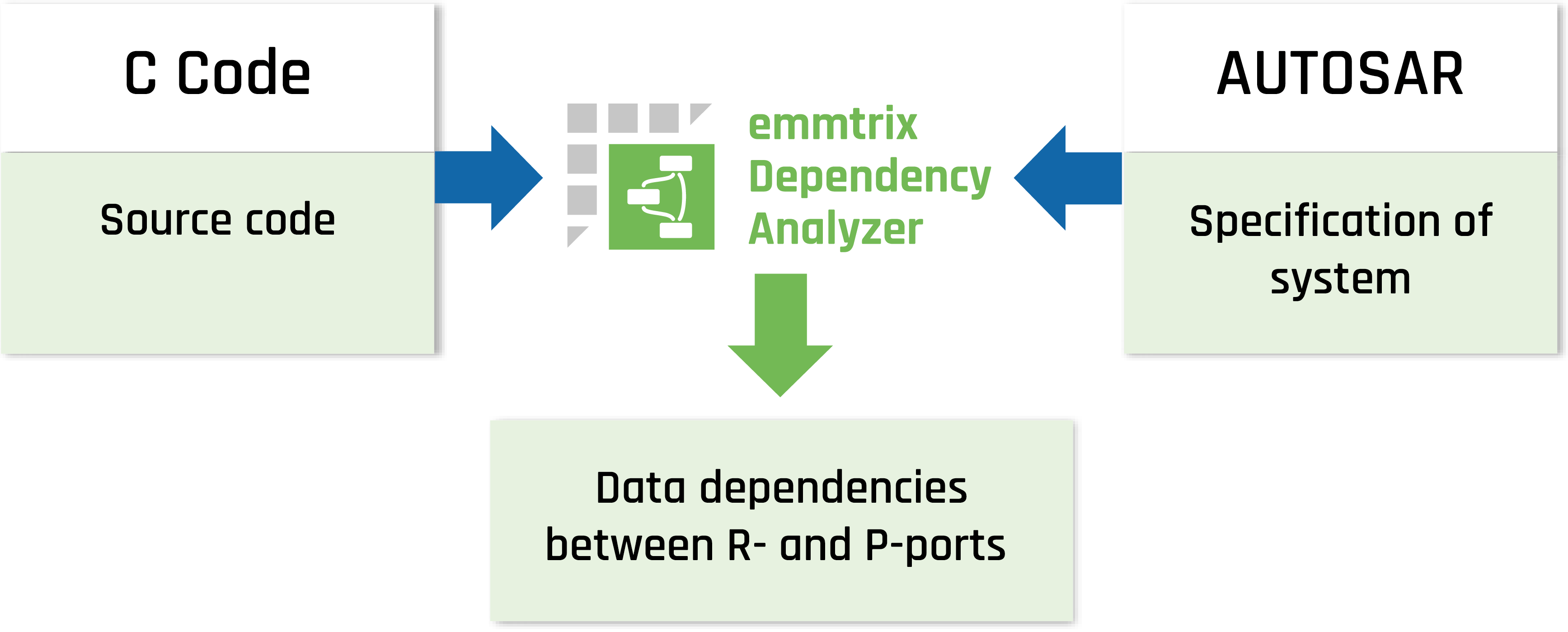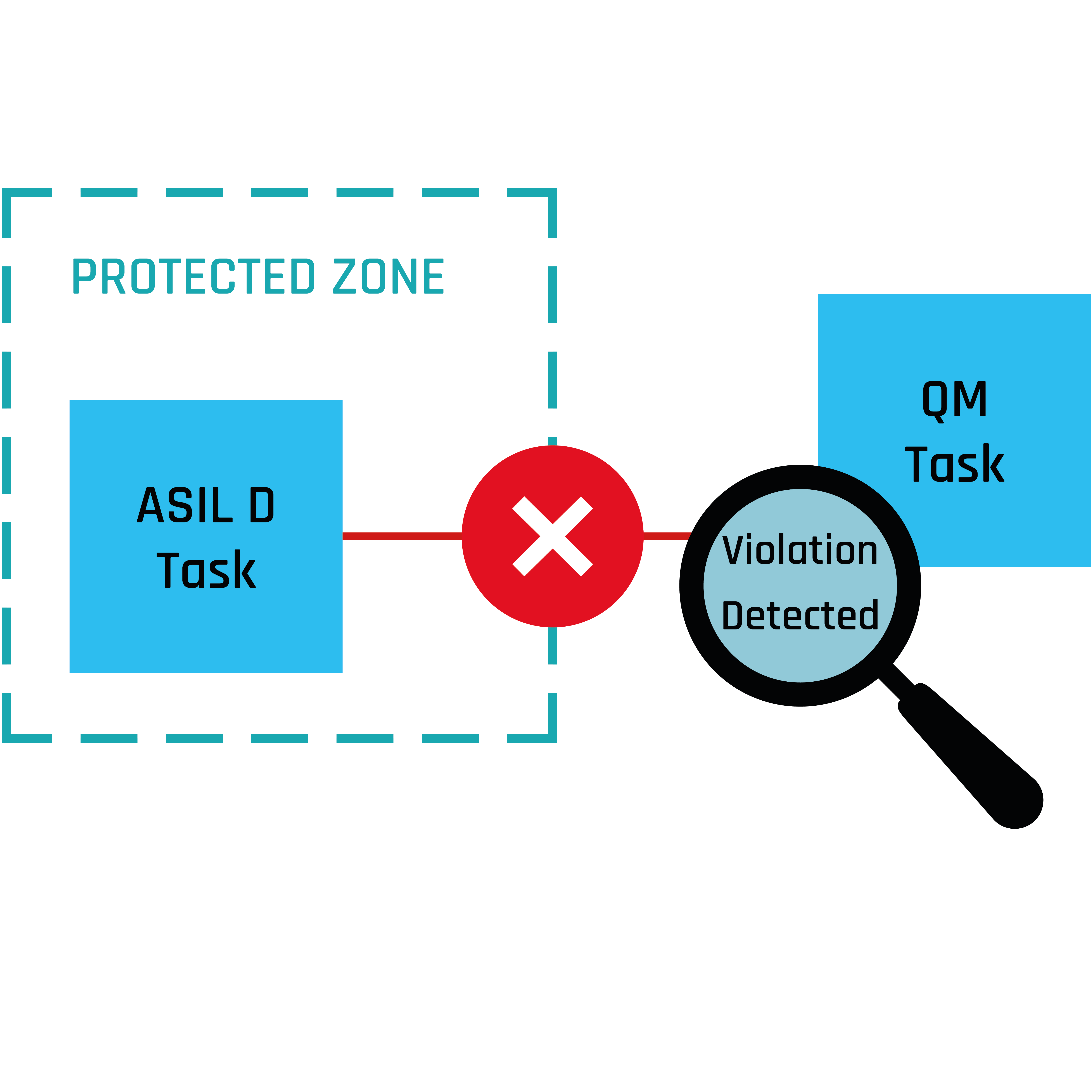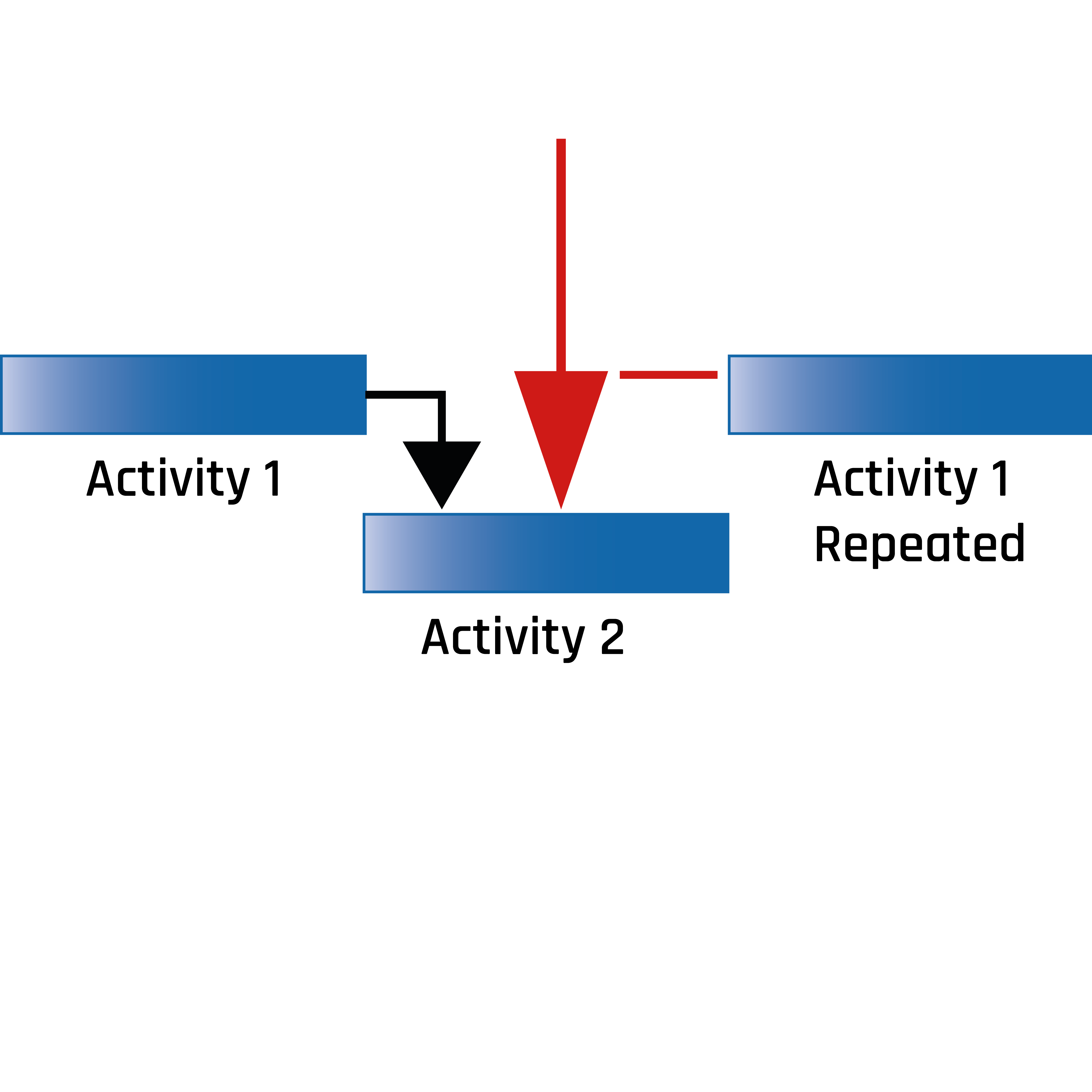emmtrix
Dependency
Analyzer (eDA)
Automatic Data Dependency and Signal Flow Analysis
emmtrix Dependency Analyzer (eDA) is an advanced tool that automates the static analysis of both legacy and AUTOSAR C code, with integrated support for analyzing the corresponding AUTOSAR model. It detects and visualizes data dependencies and signal flows by automatically analyzing how input variables influence output variables within the source code. These input and output variables correspond to signals in AUTOSAR architectures or Simulink models and are crucial for demonstrating compliance with safety and emissions standards. This capability supports safety and reliability analyses of embedded applications and helps organizations meet regulatory requirements and industry standards.
Example Use Cases – at a Glance
- Enhancing Emissions Compliance
eDA analyzes the source code of OBD software, mapping how specific input variables influence emission outputs through automated dependency and signal flow analysis. It ensures that OBD software remains compliant with stringent emission regulations and supports the generation of required documentation.
- Freedom from Interference Analysis
eDA identifies whether software components of different safety levels interfere with one another, thereby supporting compliance with safety standards, particularly ISO 26262, which focuses on ensuring freedom from interference in safety-critical systems.
- Event Chain Analysis
eDA analyzes dependencies between input and output signals within runnables, detects any timing-relevant intervening delay elements, and delivers key information for tracking event chains in the system’s dynamic architecture.
- Impact Analysis
eDA performs precise impact analysis to determine which parts of the system would be affected even before changes are implemented. This enables early assessment of costs and effort for testing and re-certification, supporting targeted and efficient resource allocation.
Designed for Automotive Scale
The tool was developed and is continuously enhanced in collaboration with automotive customers, including premium OEMs. It is designed to scale to ECUs comprising several million lines of code. To efficiently handle large codebases, individual runnables are analyzed separately, and the extracted dependencies and signal flows can later be merged for a complete system view.
Seamless Integration and Automation
Furthermore, it integrates seamlessly into CI pipelines to enable continuous analysis and comprehensive reporting.
Request your live demo today:
Prefer to talk?
Dependency Analysis of AUTOSAR Software Components
Together with customers from automotive, we have implemented support for a use case so that our emmtrix Dependency Analyzer (eDA) can be used to extract and visualize the internal data dependencies and signal flows between AUTOSAR R-Ports and P-Ports of software components (SWCs) by analyzing their internal behavior.
A typical development flow in automotive is the usage of AUTOSAR to specify different software components and runnable entities. Simulink and Stateflow are used to implement the actual functionality and TargetLink is then used to generate the C code for the target platform. All data exchange in the application is typically modelled using AUTOSAR Runnables while the source code of the runtime environment is generated at the end when all components are integrated.
Figure 1: Typical AUTOSAR Workflow with Integrated eDA
eDA can be used to automatically analyze the generated C code regarding its data dependencies. The AUTOSAR model is used as basis to generate analyzable code and the results of the source code analysis are mapped back to the data prototypes, variables and SWC ports as defined in the AUTOSAR model. This approach allows the verification that in the generated C code, all data dependencies are according to the model and no undesired connections exist between input and output ports of the model.
Results can be exported in exchange formats like XML or JSON or visualized like in the image / in interactive graphical representations below.
Figure 2: Internal Data Dependencies of a Runnable
Use Cases
Enhancing Emissions Compliance
In response to the 2015 emissions scandal, global regulatory bodies have significantly strengthened the requirements for vehicle emissions compliance and the integrity of On-Board Diagnostics (OBD) systems. Key authorities such as the Environmental Protection Agency (EPA) in the United States, the California Air Resources Board (CARB), and equivalent bodies in the European Union, under frameworks like the Euro Norms, are at the forefront of enforcing these enhanced regulations. Automobile manufacturers are now mandated to rigorously demonstrate that their vehicles, particularly the OBD software, are devoid of any manipulations and adhere to the prevailing emissions standards. This rigorous demonstration includes the submission of comprehensive documentation detailing the operation of their OBD systems. Such documentation must encompass thorough descriptions of the algorithms deployed for monitoring emissions, ensuring transparency and accountability. This step is crucial in rebuilding trust in automotive compliance and ensuring that vehicles on the road minimise emissions, aligning with initiatives like the Emission Neutral Default Action (ENDA) to mitigate any adverse environmental impacts.
The issue: Auto manufacturers face the challenge of ensuring their OBD software is fully compliant with stringent emission regulations. This entails not only adhering to legal requirements but also maintaining transparency and traceability in how the software manages and influences emissions. With regulatory scrutiny intensifying, manufacturers need a reliable method to analyze and document the behavior of their OBD systems under various conditions.
The solution: emmtrix Dependency Analyzer offers a groundbreaking solution for auto manufacturers seeking to navigate the complexities of emissions compliance. This static code analysis tool delves into the source code of OBD software, mapping out how specific input variables affect emission outputs. By identifying the intricate relationships between different components and variables, emmtrix Dependency Analyzer provides an unparalleled level of insight into the software’s operational logic.
Learn more
Our latest use case illustrates how the emmtrix Dependency Analyzer (eDA) uncovers hidden cross-domain dependencies — for example, how even a sunroof can directly impact OBD diagnostics and CARB compliance. This practical example demonstrates how eDA enables full transparency, reliable documentation, and compliance with strict regulations.
Freedom from Interference Analysis
In the development of safety-critical automotive software, ensuring the integrity and reliability of systems across varying levels of safety requirements is paramount. The emmtrix Dependency Analyzer offers a sophisticated solution to address the challenges associated with ensuring “Freedom from Interference” between components operating at different Automotive Safety Integrity Levels (ASILs). This use case outlines how the emmtrix Dependency Analyzer can be applied to identify and manage potential interference risks, thereby supporting compliance with ISO 26262 standards.
The issue: In modern automotive systems, software components with different safety requirements often share resources, such as CPUs, memory, or I/O systems. This shared environment raises the risk that lower-criticality components might interfere with the functioning of higher-criticality components, potentially leading to safety hazards. Ensuring freedom from interference is a regulatory requirement and critical for achieving functional safety certification under ISO 26262. However, manually identifying potential interference paths and ensuring isolation between components of different ASIL levels is both time-consuming and prone to human error.
The solution: emmtrix Dependency Analyzer automates the process of identifying and analyzing dependencies between software variables across different ASIL levels. By performing a comprehensive static code analysis, the tool maps out how each variable influences others, creating a detailed dependency graph that highlights potential interference risks between components of varying criticality.
Event Chain Analysis
In today’s complex software environments, understanding the dependencies and interactions between different parts of a system is critical. The emmtrix Dependency Analyzer is designed to address this challenge by providing deep insights into how variables within individual runnables influence each other across time. This use case explores the application of the emmtrix Dependency Analyzer for conducting an Event Chain Analysis, a method crucial for identifying and managing risks in software development projects.
The issue: In large-scale software projects, especially those involving real-time systems, it’s common to encounter issues related to timing, sequencing, and dependencies between tasks. Developers and project managers often struggle to trace how changes in one part of the system can affect others, potentially leading to unforeseen delays, bugs, or system failures. Without a detailed understanding of these dependencies, mitigating risks and ensuring system reliability becomes a shot in the dark.
The solution: emmtrix Dependency Analyzer offers a powerful solution by enabling users to perform a detailed analysis of dependencies within their software. By focusing on individual runnables, the tool can identify how changes in input variables affect output variables, including the detection of delay elements that indicate when a variable change will impact the system in the next time step. This capability is invaluable for constructing an accurate Event Chain Analysis, which is essential for risk identification and management.
Does one of these use cases sound familiar? Let’s talk about your specific scenario.
Features
- Highly accurate and comprehensive dependency analysis with minimal false positives, based on advanced flow-, array-, field-, and call-sensitive techniques
- Proven in use — extensively validated in real-world automotive projects and through cross-validation across multiple analysis techniques
- Supports analysis of plain C code, AUTOSAR C, and Simulink models including signal mappings and subsystem hierarchies
- Signal-flow analysis with breakdown into data and control dependencies
- Detection of stored signals across different runs (e.g. delay elements)
- Automatic AUTOSAR Run-Time Environment (RTE) generation with signal mapping
- Revealing internal model details of Simulink models (e.g. subsystems, signal and block names)
- Supports analysis of software variants by ignoring dependencies in deactivated code, subsystems, etc.
- Scales efficiently to projects with millions of lines of code through parallel processing and incremental analysis
- Consideration of internal ECU parameters (e.g. DCM, A2L)
- Comprehensive reporting with reachability graphs, dependency matrices, and traceability reports for impact and safety analysis
- Fully automated workflow with CI/CD integration
Technical Deep Dive
Learn how emmtrix Dependency Analyzer processes dependencies, integrates with CI/CD pipelines and supports AUTOSAR workflows.
Let's Get in Touch
We believe that the best solutions start with a conversation. Whether you are exploring static code analysis, performance estimation, or code optimization – we’re here to help you reach your goals faster and more efficiently.







